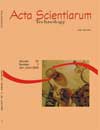<b>Desenvolvimento de uma arquitetura embarcada reativa para agentes autônomos inteligentes, aplicada ao futebol de robôs</b> - DOI: 10.4025/actascitechnol.v31i2.371
DOI:
https://doi.org/10.4025/actascitechnol.v31i2.371Palavras-chave:
arquitetura de controle embarcada, sistemas multiagentes, futebol de robôsResumo
Dentre as principais dificuldades encontradas para a construção de sistemas multiagentes em que existe a disponibilidade de um sistema de visão local, como é o caso de algumas categorias de futebol de robôs, destacam-se: necessidade de resposta em tempo real para identificação dos objetos em cena, conhecimento do ambiente, distribuição das competências de controle entre os comportamentos reativos a cargo de cada agente. O presente artigo descreve a implementação de uma arquitetura embarcada reativa para controle de Sistemas Multiagentes equipados com sistema de visão local e dotados de sensores, e sua aplicação em ambientes de futebol de robôs. Neste trabalho, foram descritas as técnicas de processamento digital de imagens e a arquitetura proposta para satisfazer í s restrições relacionadas ao problema.Downloads
Downloads
Publicado
Como Citar
Edição
Seção
Licença
DECLARAÇíO DE ORIGINALIDADE E DIREITOS AUTORAIS
Declaro que o presente artigo é original, não tendo sido submetido í publicação em qualquer outro periódico nacional ou internacional, quer seja em parte ou em sua totalidade.
Os direitos autorais pertencem exclusivamente aos autores. Os direitos de licenciamento utilizados pelo periódico é a licença Creative Commons Attribution 4.0 (CC BY 4.0): são permitidos o compartilhamento (cópia e distribuição do material em qualqer meio ou formato) e adaptação (remix, transformação e criação de material a partir do conteúdo assim licenciado para quaisquer fins, inclusive comerciais.
Recomenda-se a leitura desse link para maiores informações sobre o tema: fornecimento de créditos e referências de forma correta, entre outros detalhes cruciais para uso adequado do material licenciado.



















